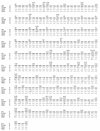Characterization of a chromosomal gene encoding type B beta-lactamase in phage group II isolates of Staphylococcus aureus
- PMID: 9835509
- PMCID: PMC106017
- DOI: 10.1128/AAC.42.12.3163
Characterization of a chromosomal gene encoding type B beta-lactamase in phage group II isolates of Staphylococcus aureus
Abstract
In contrast to most Staphylococcus aureus isolates in which the gene for staphylococcal beta-lactamase (blaZ) is plasmid borne, isolates typeable by group II bacteriophages frequently carry blaZ on the chromosome. Furthermore, the chromosomal gene encodes the type B variant of staphylococcal beta-lactamase for which the nucleotide and deduced amino acid sequences have not yet been reported. To better understand beta-lactamase production among phage group II staphylococci and the nature of the type B beta-lactamase, we determined the type and amount of enzyme produced by 24 phage group II isolates. Of these isolates, 1 did not produce beta-lactamase, 8 produced the type B enzyme, and 15 produced the type C enzyme. In all eight type B beta-lactamase-producing isolates, blaZ was located on the chromosome. This was in contrast to the type C beta-lactamase-producing isolates, in which blaZ was located on a 21-kb plasmid. The nucleotide sequence corresponding to the leader peptide and the N-terminal 85% of the mature exoenzyme form of type B S. aureus was determined. The deduced amino acid sequence revealed 3 residues in the leader peptide and 12 residues in the exoenzyme portion of the beta-lactamase that differ from the prototypic type A beta-lactamase sequence. These include the serine-to-asparagine change at residue 216 found in the kinetically similar type C enzyme, a threonine-to-lysine change at residue 128 close to the SDN loop (residues 130 to 132), and several substitutions not found in any of the other staphylococcal beta-lactamases. In summary, modern isolates of S. aureus typeable by group II phages produce type B or type C staphylococcal beta-lactamase. The type B gene resides on the chromosome and has a sequence that, when compared to the sequences of the other staphylococcal beta-lactamases, corresponds well with its kinetic properties.
Figures




References
-
- Asheshov E H. The genetics of penicillinase production in Staphylococcus aureus strain PS80. J Gen Microbiol. 1969;59:289–301. - PubMed
-
- Doebbeling B N, Pfaller M A, Hollis R J, Boyken L D, Pignatari A C, Herwaldt L A, Wenzel R P. Restriction endonuclease analysis of Staphylococcus aureus plasmid DNA from three continents. Eur J Clin Microbiol Infect Dis. 1992;11:4–8. - PubMed
Publication types
MeSH terms
Substances
Associated data
- Actions
Grants and funding
LinkOut - more resources
Full Text Sources

